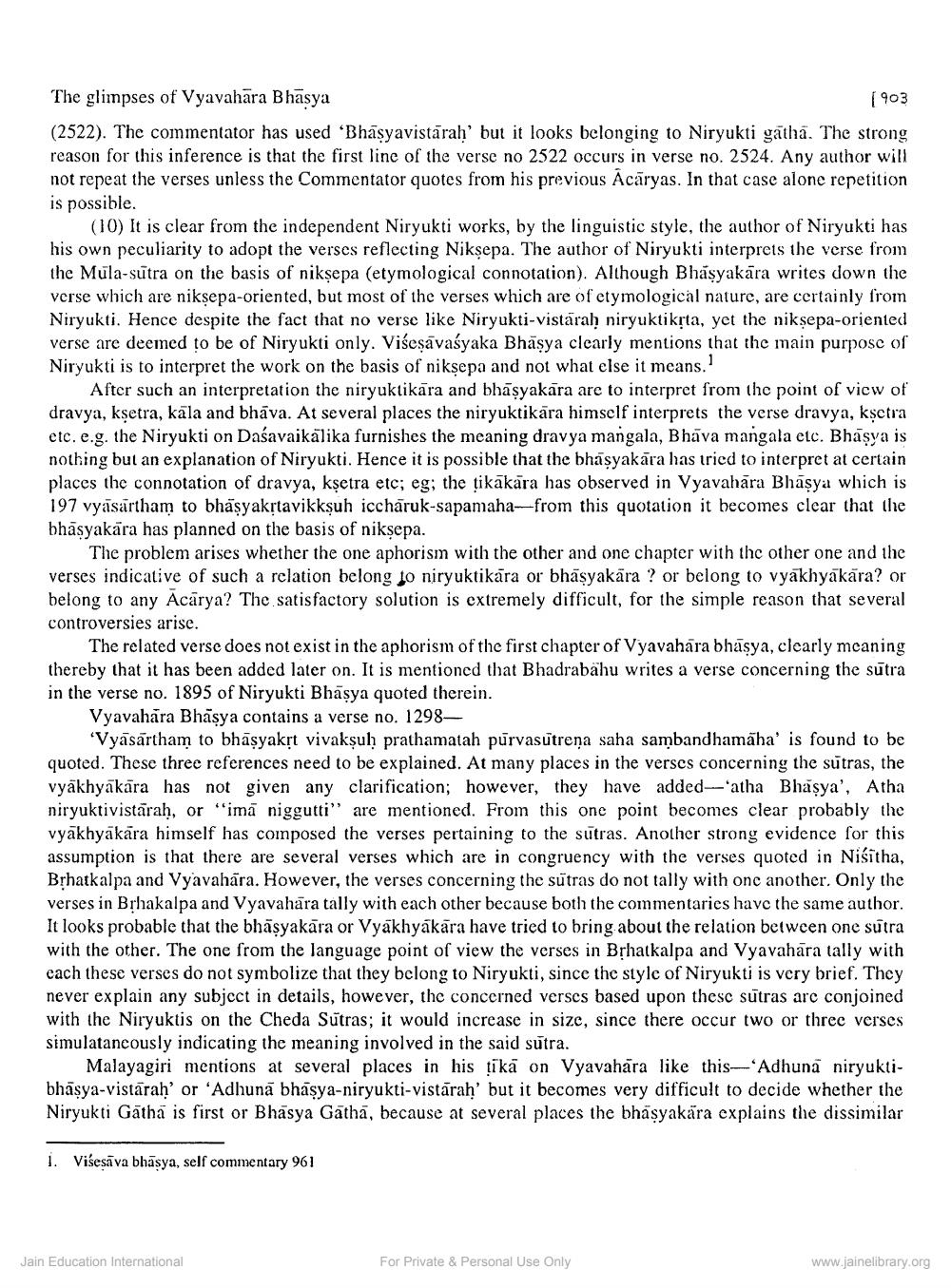________________
The glimpses of Vyavahāra Bhāsya
1903 (2522). The commentator has used 'Bhasyavistārah' but it looks belonging to Niryukti gatha. The strong reason for this inference is that the first line of the verse no 2522 occurs in verse no. 2524. Any author will not repeat the verses unless the Commentator quotes from his previous Acāryas. In that case alone repetition is possible.
(10) It is clear from the independent Niryukti works, by the linguistic style, the author of Niryukti has his own peculiarity to adopt the verses reflecting Niksepa. The author of Niryukti interprets the verse from the Mula-sutra on the basis of niksepa (etymological connotation). Although Bhasyakāra writes down the verse which are niksepa-oriented, but most of the verses which are of etymological nature, are certainly from Niryukti. Hence despite the fact that no verse like Niryukti-vistarah niryuktiksta, yet the niksepa-oriented verse are deemed to be of Niryukti only. Višesavasyaka Bhāsya clearly mentions that the main purpose of Niryukti is to interpret the work on the basis of niksepa and not what else it means."
After such an interpretation the niryuktikara and bhāsyakara are to interpret from the point of vicw of dravya, kşetra, kāla and bhāva. At several places the niryuktikāra himself interprets the verse dravya, kşctra etc. e.g. the Niryukti on Daśavaikälika furnishes the meaning dravya mangala, Bhava mangala etc. Bhasya is nothing but an explanation of Niryukti. Hence it is possible that the bhāsyakara has tried to interpret at certain places the connotation of dravya, kşetra etc; eg; the ţikakara has observed in Vyavahāra Bhasya which is 197 vyāsārtham to bhasyakrtavikksuh icchāruk-sapamaha--from this quotation it becomes clear that the bhāsyakára has planned on the basis of niksepa.
The problem arises whether the one aphorism with the other and one chapter with the other one and the verses indicative of such a relation belong to niryuktikara or bhāsyakāra ? or belong to vyakhyākāra? or belong to any Acārya? The satisfactory solution is extremely difficult, for the simple reason that several controversies arise.
The related verse does not exist in the aphorism of the first chapter of Vyavahāra bhasya, clearly meaning thereby that it has been added later on. It is mentioned that Bhadrabahu writes a verse concerning the sutra in the verse no. 1895 of Niryukti Bhasya quoted therein.
Vyavahara Bhāsya contains a verse no. 1298
'Vyāsārtham to bhāsyakst vivakşuh prathamatah purvasütrena saha sambandhamāha' is found to be quoted. These three references need to be explained. At many places in the verses concerning the sutras, the vyākhyākāra has not given any clarification; however, they have added 'atha Bhasya', Atha niryuktivistarah, or "imā nigguttiare mentioned. From this one point becomes clear probably the vyakhyākāra himself has composed the verses pertaining to the sutras. Another strong evidence for this assumption is that there are several verses which are in congruency with the verses quoted in Nisitha, Brhatkalpa and Vyavahāra. However, the verses concerning the sūtras do not tally with one another. Only the verses in Brhakalpa and Vyavahāra tally with each other because both the commentaries have the same author. It looks probable that the bhāsyakāra or Vyakhyakara have tried to bring about the relation between one sutra with the other. The one from the language point of view the verses in Brhatkalpa and Vyavahāra tally with each these verses do not symbolize that they belong to Niryukti, since the style of Niryukti is very brief. They never explain any subject in details, however, the concerned verses based upon these sutras arc conjoined with the Niryuktis on the Cheda Sutras; it would increase in size, since there occur two or three verses simulataneously indicating the meaning involved in the said sutra.
Malayagiri mentions at several places in his tika on Vyavahara like this—'Adhuna niryuktibhāsya-vistārah' or 'Adhunā bhāşya-niryukti-vistārah' but it becomes very difficult to decide whether the Niryukti Gatha is first or Bhasya Gathā, because at several places the bhäsyakära explains the dissimilar
1. Višesāva bhāsya, self commentary 961
Jain Education International
For Private & Personal Use Only
www.jainelibrary.org




